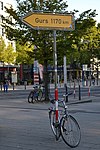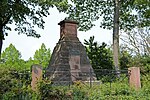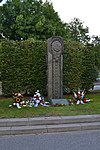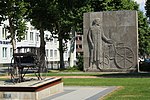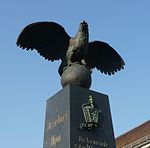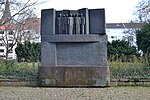List of monuments in Mannheim
The list of monuments in Mannheim shows the 36 monuments and memorials in the city (as of autumn 2017). The memorial plaques and stumbling blocks in Mannheim , the memorials in the cemeteries and the art objects in public spaces are not recorded.
list
The compilation is sorted according to the districts and then according to the year of the monument inauguration. It can also be sorted individually according to these criteria by clicking on the small arrow in the "Year" or "Sculptor" column.
| Surname | year | sculptor | Location | Picture and description |
|---|---|---|---|---|
| Grupello pyramid | 1715 1743 1895 |
Gabriel de Grupello |
City center O 1 ( Paradeplatz ) (map) |
Elector Johann Wilhelm commissioned Grupello to design a monument to be erected in the Düsseldorf palace gardens. After the death of Johann Wilhelm the complex remained unfinished and Elector Carl Philipp had it brought to Mannheim in 1738. The work was completed under the direction of Alessandro Galli da Bibiena and set up on Paradeplatz in 1743 . The extension of the monument with the fountain bowls and the water-spouting figures was created by Johannes Hoffart in 1895 . |
| Marketplace fountain | 1719 1771 |
Peter van den Branden |
City center G 1 ( market square ) (map) |
The group of figures made in 1719 for the Heidelberg Castle Garden represents the four elements . Elector Carl Theodor had the group of sculptures brought to the Schwetzingen Castle , but there was no suitable place there. Therefore he gave it to the city of Mannheim in 1767. Johann Matthäus van den Branden reworked the monument and created the base. Now the figures represent the city goddess Mannheimia, the god of trade Mercury and the river gods Neckar and Rhine. The fountain was only added in 1887. |
| Statue of St. John Nepomuk | 1748 | Paul Egell |
Downtown N 4 (map) |
After completion, the statue of St. John Nepomuk was placed on the Kapuzinerplatz in front of the Capuchin Church . In 1837 the monument was removed because it was no longer stable. In 1926 it came to the Reiss Museum . In 1990 a replica by Woytek Kaczorowski was set up on Kapuzinerplatz. |
| Veterans Memorial | 1848 | M. Arnold based on a design by Jakob Hochstetter |
City center D 5 (map) |
The veterans memorial commemorates those who died in the wars of freedom 1792–1815. Of the 1,700 soldiers of the Mannheim infantry regiment, which had to go into the Russian campaign with Napoleon in 1812 , only 100 men returned. In 1813/14 a Russian corps crossed the Rhine for the first time near Sandhofen and carried the war to the areas on the left bank of the Rhine, which were then French. |
| Schiller Monument | 1862 |
Carl Cauer (design), Ferdinand von Miller (cast) |
City center B 3 (map) |
Friedrich Schiller was in Mannheim several times. His play Die Räuber was premiered in the Nationaltheater Mannheim . The Schiller Monument was erected in front of the National Theater in B 3 in 1862. After the theater was destroyed in World War II and rebuilt on Friedrichsring, the memorial was first placed in D 6. In the 21st century it is back in square B 3, which has been redesigned into a green area. |
| Dalberg Monument | 1866 |
Max von Widnmann (design) Ferdinand von Miller (cast) |
City center N 2 (map) |
Wolfgang Heribert von Dalberg was the director of the National Theater . King Ludwig II donated the monument in 1865, which was placed in front of the National Theater in B 3 in 1866. After the theater was destroyed in the Second World War, the memorial was first erected in D 6. It has been at the Dalberghaus in N 2 since 1992 . |
| Karl Ludwig Monument | 1907 | Johannes Hoffart (draft) |
City center Ehrenhof Palace (map) |
A monument in honor of Elector Carl Theodor was planned for the city's three-hundredth anniversary . After the protest of the Baden government, the city administration decided in favor of Elector Karl Ludwig . After the destruction of the Thirty Years' War, he promoted the reconstruction and granted extended city privileges. The monument originally stood in front of the west wing of the palace . In 1958/59 it was moved to the main courtyard. |
| Karl Friedrich Monument | 1907 | Johannes Hoffart (draft) |
City center Ehrenhof Palace (map) |
At the same time as the Karl Ludwig Memorial, the Karl Friedrich Memorial was erected. After the Electoral Palatinate was dissolved , Mannheim fell to Baden . Karl Friedrich was first elector and in 1806 the first Grand Duke of Baden. The memorial initially stood in front of the east wing of the palace and was moved to the main courtyard in 1958/59. |
| Anna Hölzel memorial stone | 1907 |
City center palace garden (map) |
The Anna Hölzel memorial stone was erected in 1907 by the Pfalzgau Arts and Crafts Association and commemorates a friend of Friedrich Schiller . Schiller lived in Mannheim with Anton and Anna Hölzel. When he got into financial trouble in 1784, they granted him a generous loan. | |
| Angel of Peace | 1952 | Gerhard Marcks |
City center E 6 (map) |
The sculpture Friedensengel commemorates all victims of the Nazi regime and the Second World War . The memorial for the dead from 1933 to 1945 was inaugurated on November 16, 1952 in the presence of Federal Chancellor Konrad Adenauer in B 4. In 1983 it was given a new location in E 6 next to the town hall . |
| Flower Peter monument | 1967 | Gerd Dehof |
City center O 5 (map) |
The Blumepeter (1875-1940) was a Mannheim original . On the occasion of the 20th anniversary of the Mannheimer Morgen newspaper , the editors donated the bronze monument. It was initially located on Kapuzinerplatz in N 4, later it was moved to O 5 on the Kapuzinerplanken . |
| Neckartor | around 1970 |
Downtown Breite Strasse (map) |
In 1725 the Neckartor was built, which was the largest city gate in Mannheim and was designed accordingly. After the fortress walls were razed, it lost its function. When the construction of the first permanent bridge over the Neckar , the Chain Bridge , began in 1842 in the extension of the Breite Straße , the Neckartor was torn down. After the Breite Strasse was redesigned into a pedestrian zone in the 1970s, the monument was erected at the old location between K 1 / K 2 and U 1 / U 2. | |
| Rubble Women Monument | 1995 | Maritta Kaltenborn, Waltraud Suckow |
City center B 3 Breite Strasse (map) |
The bronze relief, which commemorates the rubble women after the Second World War , was inaugurated in 1995 by Mayor Gerhard Widder on Schillerplatz in B 3. |
| Memorial for the Sinti victims | 1996 |
City center E 6 (map) |
The memorial for the Sinti victims is located next to the Angel of Peace . It commemorates the 100 or so Mannheim families that were destroyed by the National Socialists. The simple cube was erected in 1996. | |
| Memorial for the victims of justice under National Socialism | 2002 | Jürgen Schwarz |
City Center West Wing Palace (map) |
To commemorate the victims of justice under National Socialism , the memorial was erected in front of the palace , where the Mannheim Special Court was located and the People's Court also met. Engraved are the names of the victims of 73 special court executions, more than half of which were found guilty of what would now be considered petty offenses , such as theft of groceries for personal consumption . The monument was inaugurated in 2002 by Justice Minister Ulrich Goll . |
| Memorial to the Jewish victims of National Socialism | 2003 |
Jochen Kitzbihler (design), Helmut Striffler (implementation) |
City center P 2 (map) |
A glass cube on the Mannheimer Planken , the city's main shopping street, commemorates the Jewish victims of National Socialism . The more than 2,200 victims are engraved on it in mirror writing. The cube, inaugurated on November 25, 2003, has an edge length of three meters and is oriented diagonally towards the center of Mannheim, the Paradeplatz . |
| Gurs signpost | 2006 |
Downtown Willy-Brandt-Platz (map) |
In 2006, a regional signpost with the inscription “Gurs 1170 km” was set up at the main train station . It commemorates the deportation of 2,000 Mannheim Jews to Gurs during the Wagner-Bürckel campaign on 22/23. October 1940. Few of them survived. On the initiative of the City Youth Association, the City Youth Welfare Office , the BDKJ and the City Archives , young people from Mannheim dealt with the history of the deportation and created an exhibition and documentation. The local council supported the project and had the sign put up. The same sign with a different kilometer indication is on the square of the Old Synagogue in Freiburg im Breisgau. | |
| Memorial for the victims of forced sterilization under National Socialism | 2013 | Michael Volkmer | Downtown |
The transportable memorial was created on the initiative of the “Working Group on Justice and the History of National Socialism in Mannheim”. It represents a large stack of 1000 cubes fused into a homogeneous and anonymous mass, but which are designed very similar to one another. Each of them symbolizes an individual fate, but they are interrelated.
The first place of installation was in front of the district court, later the memorial is to be erected step by step in front of the institutions that were involved in the sterilization, such as the university clinic, the Diakoniekrankenhaus or the health department. Mannheim. |
| Sack Porter Monument | 1983 | Gerd Dehof |
Jungbusch Beilstrasse (map) |
The Jungbusch district is closely linked to the Mannheim harbor . Thousands of bag carriers once found work unloading the ships. Mayor Gerhard Widder inaugurated the memorial dedicated to them on September 17, 1983 . |
| Stephaniedenkmal | 1907 | Konrad diver |
Lindenhof Stephanienufer (map) |
Carl Reiss donated the monument that commemorates the Grand Duchess Stéphanie de Beauharnais . She had the palace garden redesigned and opened to the public. The monument stands on the Stephanienufer named after her . The sculptor created it after a painting by François Gérard . |
| Heinrich Lanz Monument | 1910 | August Kraus |
Lindenhof John Deere Works (Map) |
Heinrich Lanz was the founder of the agricultural machinery factory Heinrich Lanz AG , which became John Deere . The memorial was created five years after Lanz's death. The 3.60 meter high bronze statue stands on a 3.31 meter high base made of shell limestone. |
| Memel memorial stone | 1961 |
Lindenhof Rheinpromenade (map) |
The Memel memorial stone commemorates the longstanding partnership between the cities of Mannheim and Memel, since 1945 Klaipėda . When Russia invaded East Prussia in 1915, the German Association of Cities called for help. Several cities in Baden got involved, including Mannheim, which continued to help even after the First World War and took over a sponsorship in 1928. The sponsorship was renewed in 1953 and in 1961 the Memel memorial stone was erected not far from the Rhine. In 2002 Mannheim and Klaipėda signed a city partnership. |
|
| Feudenheim synagogue | 1965 |
Feudenheim Neckarstrasse (map) |
The synagogue in Feudenheim was built in 1819 and probably rebuilt in 1840/41. On November 9, 1938, she was cremated during the Night of the Reichspogrom. The remains of the Feudenheim synagogue were made visible and inaugurated as a memorial in 1965. | |
| Memorial to the battle of Seckenheim | 1890 |
Friedrichsfeld Schwabenstrasse (map) |
A memorial to the Battle of Seckenheim in 1462 was erected in the Palatinate era . There was a crucifix on a red sandstone plinth. The monument was 4.75 meters high. Elector Carl Theodor had the damaged monument secured in the 18th century and a new crucifix made. This was destroyed in 1823. The old base was put into the castle museum. In 1890 , the Mannheimer Altertumsverein had the current one built on the site of the old monument . | |
| Monument to the Rhine crossing in 1814 | 1914 |
Friesenheimer Insel Friesenheimer Strasse (map) |
During the Wars of Liberation , the Russian von Sacken corps and Blücher's army crossed the Rhine near Mannheim on January 1, 1814. In commemoration of this, the Mannheim Military Association had a three-sided stele crowned with cannonballs erected at the next possible onshore location in the industrial port . | |
| Memorial to the memory of the 1982 helicopter disaster | 1983 | Michael Sandle |
Neuostheim Seckenheimer Landstrasse (map) |
During the International Airship Days for the 375th anniversary of the city , a Boeing transport helicopter of the US Army crashed on September 11, 1982 . 46 people died. Mayor Gerhard Widder unveiled the monument designed by the British sculptor a year after the accident at Mannheim Airport . |
| Carl Benz Memorial | 1933 2008 |
Max Laeuger |
Oststadt Augustaanlage (map) |
The monument to the Mannheim automobile pioneer Carl Benz was inaugurated on April 16, 1933 by Transport Minister Paul von Eltz-Rübenach . The shell limestone relief stands at the transition from the Augustaanlage to Friedrichsplatz . In 2008 it was supplemented by a true-to-original bronze cast of the Benz patent motor car . It was donated by Daimler AG on the occasion of the centenary of the Benz plant in Mannheim-Waldhof . |
| Ludwig Frank Monument | 1950 | Bernhard Bleeker |
Oststadt Luisenpark (map) |
Ludwig Frank from Mannheim was a leading social democrat and member of the Reichstag. He died in the First World War . The Reichsbanner Schwarz-Rot-Gold erected a monument in the Lower Luisenpark in 1924, which the National Socialists removed in 1933. After the Second World War, a youth figure was erected to commemorate Frank and the other victims of the First World War. |
| Memorial stone to the 1994 helicopter accident | around 1995 |
Oststadt Hans-Reschke-Ufer (map) |
In December 1994 a German Army helicopter rammed the telecommunications tower on its return flight from a rescue mission . The 17 meter high peak broke off and the helicopter crashed . All four crew members were killed. The memorial is located at the foot of the telecommunications tower. | |
| War memorial | 1933 |
Rheinau Durlacher Strasse (map) |
The war memorial in Rheinau commemorates those who died in the First World War. It was donated by the Mannheim-Rheinau Warrior and Military Association and inaugurated in 1933. | |
| Draisdenkmal | 2003 |
Rheinau Karlsplatz (map) |
Karl Drais invented the forerunner of today's bicycle with the draisine . He made his first long trip in 1817 from Mannheim Castle to the Schwetzinger Relaishaus, which was located near what is now Karlsplatz in the Rheinau district. In commemoration of this, the memorial was erected nearby in 2003. The square with an edge length of 2.50 meters symbolizes the square city of Mannheim. A stylized stainless steel trolley one meter high is mounted on it. | |
| War memorial | J. Roth from Baden-Baden (design and execution) |
Sandhofen Kriegerstrasse (map) |
The war memorial in Sandhofen commemorates those who fell in the Franco-German War in 1870/71 . The imperial eagle is located on a granite obelisk. | |
| Memorial to the memory of the resistance group Georg Lechleiter | 1988 | Manfred Kieselbach |
Schwetzingerstadt Georg-Lechleiter-Platz (map) |
The Georg-Lechleiter-Platz of the communist member of the state parliament and Mannheim city councilor Georg Lechleiter , who as head of a resistance group fought against the Nazi injustice system, has been commemorated since 1945 . 19 members of the group were executed in 1942/43; another three had previously died in custody. On February 24, 1988, a bronze memorial was unveiled to commemorate this event. |
| Bismarck Monument | 1900 | Emil Hundrieser |
Schwetzingerstadt Bismarckplatz (map) |
As the adoration of the deposed Chancellor Otto von Bismarck began , a Bismarck monument was also inaugurated in Mannheim. It consisted of the Bismarck figure on a pedestal, on the steps of which sat a Teuton with a shield and sword. During the Second World War, the monument that was located at the intersection of Bismarckstrasse and Kaiserring was damaged. The Bismarck figure was retained and was given its current location in 1980. |
| Nepomuk statue | 1950 |
Seckenheim Stengelstrasse |
Behind the choir of St. Aegidius Church there is a statue of Nepomuk made of red sandstone. It was originally set up on a bridge on Schwabenstrasse before it was moved here. The heavily damaged original from the 18th century was replaced by a copy around 1950. | |
| War memorial | 1926 | Franz Yellow |
Waldhof Otto-Siffling-Strasse (map) |
After the First World War, a war memorial was erected in Waldhof . The inscription was later expanded to include the dead of World War II. The sculptor designed the equestrian sculpture in the New Objectivity style . |
literature
- Hans Huth: The art monuments of the Mannheim II district . Munich 1982, ISBN 3-422-00556-0
- Memorial sites for the victims of National Socialism . Volume 1. Bonn 1995, ISBN 3-89331-208-0
Web links
Individual evidence
- ^ Rolf Selbmann: Poet monuments in Germany. Literary history in ore and stone . (PDF) Publication by the University of Munich, JB Metzler'sche Verlagsbuchhandlung. P. 97.
- ↑ Page no longer available , search in web archives: Mannheimer Morgen, August 25, 2009
- ↑ Page no longer available , search in web archives: Mannheimer Morgen, October 17, 2008
- ↑ Page no longer available , search in web archives: Mannheimer Morgen, September 13, 2002
- ^ City of Mannheim
- ↑ Page no longer available , search in web archives: Mannheimer Morgen December 6, 2006
- ^ Memorial to the Victims of Forced Sterilization , accessed on September 25, 2017.
- ↑ Page no longer available , search in web archives: Mannheimer Morgen, August 1, 2002
- ^ Association of Displaced Persons ( Memento of the original from October 9, 2014 in the Internet Archive ; PDF; 6.0 MB) Info: The archive link has been inserted automatically and has not yet been checked. Please check the original and archive link according to the instructions and then remove this notice.
- ↑ Page no longer available , search in web archives: Mannheimer Morgen, September 12, 2011
- ^ City-Airport Mannheim , history
- ↑ Page no longer available , search in web archives: Mannheimer Morgen, 23 August 2008
- ^ Hanspeter Rings: Rheinau: Illustrated history of a Mannheim suburb . Mannheim 1988, ISBN 3-923003-39-0 , p. 123.
- ↑ Page no longer available , search in web archives: Mannheimer Morgen, September 3, 2003
- ↑ Page no longer available , search in web archives: Mannheimer Morgen, February 9, 2007




